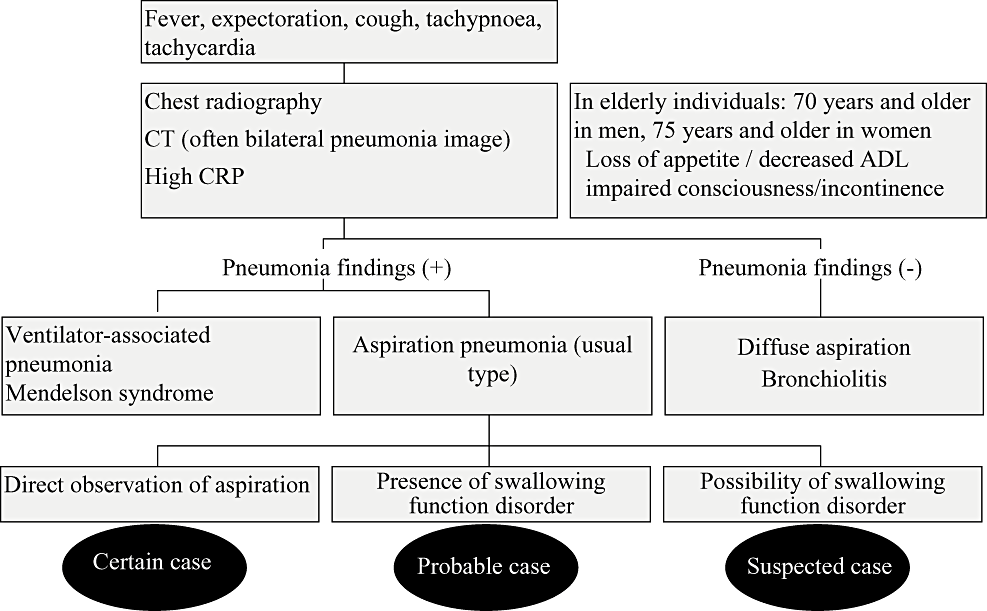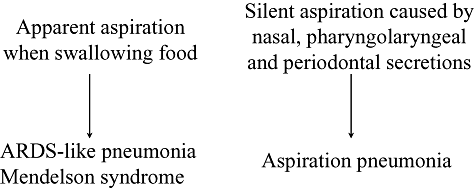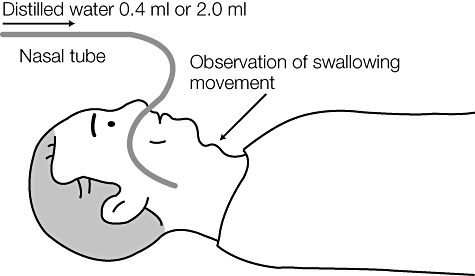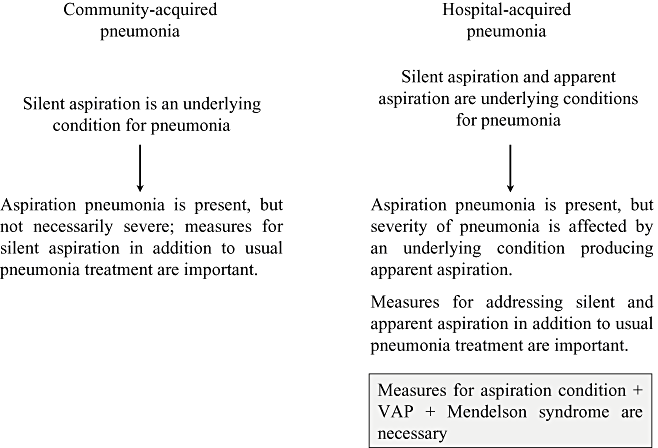Aspiration pneumonia
SUMMARY
• Aspiration pneumonia is diagnosed upon confirmation of inflammatory findings in the lungs and overt aspiration (apparent aspiration) or a condition in which aspiration is strongly suspected (abnormal swallowing function and dysphagia).
• In hospital-acquired pneumonia, this occurs as one consequence of frequent silent aspiration.
• In the diagnosis of aspiration pneumonia, evaluation of the risk of silent aspiration during the night and evaluation of swallowing function are important.
• The causative microorganisms in aspiration pneumonia, similar to community-acquired pneumonia, are basically thought to be bacteria residing in the oral cavity, such as pneumococcus, Haemophilus influenzae, Staphylococcus aureus and anaerobes.
• Hospital-acquired aspiration pneumonia often occurs with no distinction between apparent and silent aspiration, and in many cases, aspiration of foreign substances is serious when dysphagia itself is severe.
• In the treatment of aspiration pneumonia, use of antimicrobials for the pneumonia itself and early measures to prevent aspiration are important.
DEFINITION OF ASPIRATION PNEUMONIA
The term ‘aspiration pneumonia’ has long been used, but this condition is also called ‘hypostatic pneumonia’ and deglutition pneumonia, and no single theory has been accepted regarding the conditions necessary for diagnosis. A review by Marik1 provides an explanation of conditions, but no clear diagnostic criteria. In other words, although the term ‘aspiration pneumonia’ is pervasive, clear definitions are lacking.
A committee was formed in Japan to study aspiration pulmonary diseases, and the forms of the disease were classified and defined (Table IX-1).2 The committee categorized four aspiration pulmonary diseases: aspiration pneumonia (usual type)3,4, diffuse aspiration bronchiolitis5,6, Mendelson syndrome7 and ventilator-associated pneumonia (VAP).8 Based on pathological characteristics, these diseases were classified into three categories, with Mendelson disease and VAP as one group alongside aspiration pneumonia (normal type) and diffuse aspiration bronchiolitis (Table IX-1).
| Concept of aspiration pulmonary disease (APD): |
| Pulmonary disease caused by abnormal swallowing function or dysphagia |
| Classification of APD: |
| APD is classified as depending on the properties, amount and distribution of the aspirated foreign substance. |
| Aspiration pneumonia (usual type) is synonymous with deglutition pneumonia. |
| • Aspiration pneumonia (usual type) |
| • Ventilator-associated pneumonia (VAP) |
| • Mendelson syndrome |
| • Diffuse aspiration bronchiolitis (DAB) |
In the present guidelines, VAP is dealt with in Chapter VIII. Aspiration pneumonia (usual type), the most frequent of the above types, is diagnosed following confirmation of inflammatory findings in the lungs and overt aspiration (apparent aspiration), a condition in which aspiration is strongly suspected, or the existence of abnormal swallowing function or dysphagia (Fig. IX-1). In fact, as direct confirmation of aspiration (apparent aspiration) is rare, diagnosis is considered to be possible based on the existence of abnormal swallowing function or dysphagia, infiltrative shadows on chest radiography and elevated peripheral white blood cell count (≥10 000/µL). Aspiration pneumonia can thus be diagnosed if pneumonia occurs in a patient with known dysphagia when no other clear causes can be found. An evaluation of whether a swallowing function disorder exists is thus needed for pneumonia patients.2

Diagnostic flow chart for aspiration pulmonary disease. ADL, activity of daily living.
RELATIONSHIP BETWEEN ASPIRATION AND ASPIRATION PNEUMONIA: DISTINGUISHING BETWEEN APPARENT AND SILENT ASPIRATION (Fig. IX-2)

Relationship between aspiration and aspiration pneumonia—distinguishing between apparent and silent aspiration.
Aspiration may occur in conditions of impaired swallowing function, but the occurrence of aspiration and the development of pneumonia are different things.
Recent research has clearly reconfirmed a cause-and-effect relationship between aspiration and aspiration pneumonia.3,4 Aspiration needs to be divided into apparent aspiration, as when choking in swallowing during meals, and silent aspiration of unnoticed nasal, throat and periodontal secretions that mainly occur at night. Distinguishing between these two forms is the first step. With the exception of Mendelson syndrome, aspiration pneumonia occurring from apparent aspiration is rare, and we need to be aware that hospital-acquired pneumonia occurs as one consequence of frequent silent aspiration. This means that, as a rule, hospital-acquired aspiration pneumonia should be considered to occur without any relationship to ingestion of food. Even fasting or the placement of a gastric fistula do not provide absolute protection against pneumonia.9–12 This is because upper airway reflexes decrease during the night, and sleep, sedatives and psychotropic agents not only inhibit swallowing reflexes to cause silent aspiration, but also represent factors exacerbating dysphagia. Even healthy, aged people reportedly do not swallow for periods of more than 30 min during the night, and secretions that accumulate in the laryngopharynx during this time are aspirated.13
In situations where people have to be hospitalized, silent aspiration should be assumed to be occurring with high frequency, regardless of time during the day or night. When frequent aspiration is seen during meals, ARDS-like pneumonia may occur centred on hydrochloric acid-induced lung injury, similar to Mendelson syndrome. However, this should be considered a rare condition among the overall number of hospital-acquired pneumonias.
METHODS OF EVALUATING SWALLOWING FUNCTION TO DIAGNOSE ASPIRATION PNEUMONIA (Table IX-3)
| (Listed in order from highest sensitivity and specificity) |
| 1 Confirmation of uptake into lungs of radioisotopes applied to teeth |
| 2 Swallowing provocation test |
| 3 Simple swallowing provocation test (Tokyo University Method procedure) |
| 4 Videofluoroscopy |
| 5 Water swallowing test |
Swallowing function needs to be evaluated when diagnosing aspiration pneumonia, and various methods are available for this purpose, including the water swallowing test,14–16 repetitive saliva swallowing test,17 swallowing provocation test18–20 and videofluoroscopic examination of swallowing.21–24 All of these methods are useful in the diagnosis of swallowing disorders, but tests to diagnose aspiration pneumonia differ from tests to detect ingestion and swallowing disorders. Videofluoroscopic examination of swallowing and similar methods of evaluating ingestion and swallowing disorders are performed with the patient in a sitting position, and are not directly related to hospital-acquired pneumonia. Swallowing disorder tests that enable evaluation of the risk of silent aspiration during the night or when the patient is unaware are important in the diagnosis of aspiration pneumonia (Tables IX-2,3). Special tests to evaluate ingestion and swallowing function, such as videoendoscopy and videofluoroscopic examination of swallowing, are unrelated to the prediction of pneumonia, and no evidence for the utility of these tests has been reported.
| 1 Screening method |
| • Bedside swallowing function evaluation |
| • Changes in arterial oxygen saturation when swallowing at bedside |
| • Repetitive saliva swallowing test |
| • Water swallowing test |
| 2 Swallowing function evaluation |
| • Water swallowing test |
| • Videofluoroscopy |
| • Videoendoscopy |
In contrast, the simple swallowing provocation test (Tokyo University Method) (Fig. IX-3)25,26 is a swallowing function test that can be conducted with patients in a supine position. This practical test can be done at the bedside, and offers superior sensitivity and specificity in detecting swallowing disorders that lead to pneumonia.26 In terms of simplicity, the water swallowing test is also useful.25,27 Regardless of form, if a patient can swallow water well, swallowing function is thought to be relatively maintained. Conversely, patients who cannot swallow water well are considered to display a swallowing disorder, providing grounds for a diagnosis of aspiration pneumonia.25,27

Simple swallowing provocation test (Todai procedure).
The surest method of demonstrating invasion into the lungs of oropharyngeal secretions that should not essentially be there is the method4,28 of attaching gauze coated with indium111 chloride or other radioisotopes to the patient's teeth, then checking on the uptake of radioisotope in the lungs the following day using a γ-camera. This method is not actively recommended, however, based on ethical considerations and diagnostic significance. If a patient has dysphagia, aspiration should be assumed to occur constantly throughout the night, but even a small amount of foreign matter taken into the lungs does not affect the subsequent treatment strategy. Rather, even without conducting such tests, silent aspiration should be assumed to occur in nearly all aged individuals, and assuming that silent aspiration occurs in cases where good swallowing function cannot be confirmed is reasonable.
CONDITIONS AND UNDERLYING DISORDERS LIKELY TO CAUSE DYSPHAGIA
Aspiration pneumonia is caused by aspiration or mis-swallowing of foreign substances, so dysphagia patients and underlying conditions that cause swallowing difficulties need to be well understood. The most frequent underlying condition is acute or previous cerebral infarction (Table IX-4). In the acute phase, apparent aspiration is the main form, and aspiration should be assumed to be occurring continually.29–32 In contrast, apparent aspiration in the chronic phase is not seen in most cases, while silent aspiration is almost certainly occurring. Pneumonia may thus occur with different aspiration mechanisms as the condition changes from onset of infarction to the chronic phase.
| • Previous or acute cerebrovascular disorder |
| • Neurodegenerative disorder and neuromuscular disease |
| • Impaired consciousness, cognition disorder (dementia) |
| • Gastroesophageal reflux, gastrectomy (particularly total gastrectomy) |
| • Laryngeal, pharyngeal tumour |
| • Tracheotomy with cuffed tube, nasogastric tube replacement |
Old age is also a risk factor.33–35 The swallowing reflex declines with aging alone, but delays or declines in the swallowing reflex are also seen from shift of the larynx to a lower position and decreases in saliva secretion. Declines in the cough reflex and impaired swallowing and breathing coordination are also seen in aged people.
Patients with neuromuscular disease are also susceptible to apparent and silent aspiration. Decreased swallowing function and cough reflex have been reported in Parkinson's disease patients.36,37 Sleep suppresses neuron projection in the upper airway reflex from the brain, along with cough and swallowing reflexes.13,38 Silent aspiration thus occurs frequently during the night.
Sedatives, sleeping medications and psychotropic agents also cause declines in the swallowing reflex via projection pathways or muscle relaxation effects, producing apparent and silent aspiration.39,40 Oversedation after hospital admission should also be considered as a frequent cause of silent aspiration. In animal experiments, this phenomenon is seen more clearly in old animals, and excessive doses of these medications in aged people are thought to raise the risk of pneumonia.39,40
Aspiration also occurs in patients who have undergone gastrostomy. This is not reflux from the stomach, but microaspiration that occurs in the supine position during the night. This evidence supports the supposition that aspiration pneumonia in dysphagia patients is not a pneumonia resulting from choking during meals, but rather a pneumonia caused by microaspiration from silent aspiration. Of note is the fact that aspiration pneumonia also occurs in patients with a nasogastric tube or tracheal cannulation.
In nasogastric tube patients, reflux to the pharynx occurs during the night, with the gastric tube acting as a conduit, and reflux material accumulated in the pharynx is repeatedly aspirated. The tracheal cannula itself interferes with laryngeal elevation and facilitates microaspiration.
CAUSATIVE MICROORGANISMS
The causative microorganisms in aspiration pneumonia, similar to community-acquired pneumonia, are basically thought to be bacteria residing in the oral cavity, such as pneumococcus, Haemophilus influenzae, Staphylococcus aureus and anaerobes. Although little evidence of hospital-acquired pneumonia is available from cases, many reports have described pneumococcus, Staphylococcus aureus, Klebsiella and Enterobacteriaceae in aspiration pneumonia.41–44 In a Japanese study of bacteria isolated from 40 pneumonia and pulmonary suppuration patients using percutaneous pulmonary aspiration biopsy, bacteria residing in the oral cavity were indicated to be involved, including Streptococcus anginosus (Streptococcus milleri group), α-streptococcus and anaerobes.45 Of the 40 patients, Peptostreptococcus was detected in seven and Bacteroides in six.45
DIFFERENCES IN ASPIRATION PNEUMONIA WITH HOSPITAL-ACQUIRED AND COMMUNITY-ACQUIRED PNEUMONIA (Fig. IX-4)

Differences in aspiration pneumonia between community-acquired pneumonia and hospital-acquired pneumonia.
Aspiration is a cause of both of these types of pneumonias, but community-acquired aspiration pneumonia is different from silent aspiration, and many cases of hospital-acquired aspiration pneumonia occur without distinction between apparent and silent aspiration. Dysphagia itself is severe and aspiration is serious in many cases. In Western countries, diagnosis and measures are for clinical manifestations of mainly ventilator-associated pneumonia (VAP) in nearly all cases of hospital-acquired pneumonia. In understanding aspiration pneumonia in Japan, it is easier to think of measures against hospital-acquired pneumonia as being in addition to measures against VAP (Refer to Chapter VIII).
In patients, such as those with impaired consciousness who have severe aspiration that has become constant, a high possibility exists for frequent aspiration of not only pharyngeal secretions, but also secretions from chronic inflammation of the nasal cavity, food residue and content from the stomach and intestinal tract, including regurgitant digestive juice. Treatment thus needs to be done out of consideration of the possibility that not only viruses and bacteria, but also large amounts of digestive fluids, including saliva and bile, have been aspirated.
ANTIBACTERIAL AGENTS
Major pathogens are bacteria residing in the oral and nasal cavities and Gram-positive bacteria, and sound treatment for these bacteria is important. Unless the pneumonia is very serious or accompanied by sepsis, initial treatment with ampicillin/sulbactam, which is a β-lactam/β-lactamase inhibitor combination, usually has a sufficient effect.46
NON-DRUG TREATMENT OF ASPIRATION PNEUMONIA
Aspiration pneumonia occurs with silent aspiration during the night, which is almost universal in aged people. However, not all aged people develop pneumonia. This means that a single episode of silent aspiration does not immediately result in pneumonia. From the perspectives of treatment and prevention, therefore, it is important to combine approaches to make aspiration more unlikely with approaches to prevent pneumonia even if aspiration does occur. Pneumonia treatment that does not use antimicrobials should also be conducted simultaneously with treatment using antimicrobials (Table IX-5). Placing and leaving patients in a supine position while undergoing treatment for pneumonia is sure to exacerbate silent aspiration. Measures that should be implemented to prevent silent aspiration from this time include elevating the head (bed), oral care and dental treatment. Poor nutrition, muscle deterioration and decreased consciousness individually or together make swallowing difficult and increase aspiration, and measures to address these factors are important.
| 1 Measures and treatment for apparent aspiration |
| Swallowing rehabilitation, eating assistance, investigation of meal contents, swallowing training, strengthening of swallowing muscles (speech training), continuous suction of pharynx, thorough oral care, change of alimentation route (such as nasogastric tube feeding or percutaneous endoscopic gastrostomy: PEG), avoidance of long-term placement of nasogastric tube, swallowing training after placement of nasogastric tube, measures to prevent gastroesophageal reflux (drug treatment, body position), improvement of enteric peristalsis |
| 2 Measures and treatment for silent aspiration |
| • Elevate bed (head) slightly during night |
| • Improve bacterial flora of the mouth |
| Clean oral cavity (gargle, brush teeth), oral care, dental treatment |
| • Administer substances to improve swallowing function in the group of patients, such as angiotensin-converting enzyme (ACE) inhibitors or cilostazol |
| • Prevent dehydration, improve nutrition |
| • Try to raise consciousness level and stop or reduce substances that inhibit swallowing reflex (discontinue sedatives and sleep medications, maintain head-up position during day) |
CONFLICT OF INTEREST
No conflict of interest has been declared by The Committee for the Japanese Respiratory Society guidelines for the management of respiratory infections.




